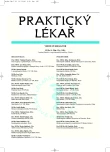Recent advances in the pain pathophysiology and theirs possible applications for the treatment of pain.
Nové poznatky v patofyziologii bolesti a jejich možné projekce do léčby bolesti
V článku jsou popsány některé novinky molekulárních a iontových změn při bolestivém vnímání zejména u sodíkových kanálů, dále novinky v terapii bolesti jako jsou náplasťové formy léčení neuropatické bolesti a nově zaváděná metoda molekulárně biologické mikrochirurgie. Zmíněny jsou i metody neuromodulační, které jsou velmi efektivní u nejrůznějších typů bolesti, a opět jsou velmi účinné u bolesti neuropatické. V článku je rozebrána i psychoterapie, placebo efekt a akupunktura. Zobrazovací metody přinášejí nové pohledy na dráhy bolesti a její lokalizaci v mozkové kůře. Jsou rozebrány i další možnosti léčby bolesti, a to ve speciálních situacích jako je dětská bolest a bolest ve stáří. Jako úplná novinka je zmíněna tetrapartitní synapse, která hraje zásadní roli při bolestivé transmisi, do níž je kromě neuronů vzata i mikroglie a astrocyt. V článku jsou zmíněny i některé další výsledky z 11. Světového kongresu o bolesti v Sydney v roce 2005 a z prvního Lékařského kongresu České lékařské akademie „Bolest je všudypřítomná“ v Liberci v roce 2006.
Klíčová slova:
bolest, sodíkové kanály, tetrapartitní synapse, terapie
Authors:
R. Rokyta
Authors‘ workplace:
3. Lékařská fakulta, Univerzita Karlova, Praha
přednosta: prof. MUDr. Richard Rokyta, DrSc.
; Ústav normální, patologické a klinické fyziologie
Published in:
Prakt. Lék. 2006; 86(7): 387-390
Category:
Various Specialization
Overview
This article sets out to describe some of the recent advances in molecular and ion changes on pain perception, especially in sodium channels, and to outline current developments in pain therapy, such as transdermal forms of the treatment of neuropathic pain and the newly introduced method of molecular biological microsurgery. Neuromodulation methods are also described, which are very efficient for different types of pain, especially for neuropathic pain. The article also takes an analytical look at psychotherapy, the placebo effect and acupuncture. Imaging techniques are bringing new insights into the pathways of pain and their localization in the brain. Other possibilities for the treatment of pain in special situations, such as child’s pain and the pain in old age, are also looked at. The most recent research on the tetrapartite synapse is also outlined. The tetrapartite synapse plays a key role in pain transmission to which, Motto: Při současných znalostech jsme schopni snížit nebo vyléčit až 90 % všech typů chronické bolesti.
in addition to neurons, the microglia and astrocyte are extremely important. Other results from the 11th World Congress on Pain in Sydney, 2005, and from the 1st Medical Congress of the Czech Medical Academy „Pain is omnipresent” in Liberec, 2006 are also mentioned.
Key words:
pain, sodium channels, tetrapartite synapsis, therapy.
Labels
General practitioner for children and adolescents General practitioner for adultsArticle was published in
General Practitioner

2006 Issue 7
- Metamizole vs. Tramadol in Postoperative Analgesia
- Metamizole at a Glance and in Practice – Effective Non-Opioid Analgesic for All Ages
- Memantine in Dementia Therapy – Current Findings and Possible Future Applications
- Hope Awakens with Early Diagnosis of Parkinson's Disease Based on Skin Odor
- Possibilities of Using Metamizole in the Treatment of Acute Primary Headaches
Most read in this issue
- The diagnostic process in primary health care – the most frequent sources of errors and possibilities for their elimination
- Post-exercise acute rhabdomyolysis – benign sign or symptom of serious muscular disease?
- Entecavir is new drug for chronic hepatitis B treatment
- Recommended diagnostic steps for general practitioners attending patients with difficulties that could indicate multiple myeloma
